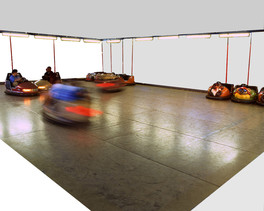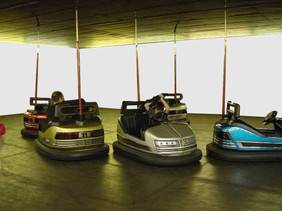Excursus: Welcome to the AVANT-GARDE Theme Park
2006
The theme park has become the model for almost all contemporary forms of presentation and consequently can no longer be reduced to the thematic attractions of a leisure park.
Even if the prehistory of the theme park was largely shaped by the baroque pleasure garden, the maze, the amusement park, world exhibitions etc., then today one can observe how the theme park concept influences the development of the museum, the exhibition and contemporary art production.
Insofar as this development was observed at all, it has been judged entirely negatively and pejoratively and interpreted as a threat to a high culture. Hardly anyone appeared to consider it necessary to analyse these changes more carefully - changes not only in forms or presentation, but also ones that represented rather a radical alteration in ways of reception.
Since the 18th century the reception of art has been dominated by the dictums of sensibility, such as are described eg in Rameauís Nephew by Diderot. Education (and refinement - Bildung) was supposed to aid the recipient in his sensitive/sensible perception.
Meanwhile the attractions of a theme park are perceived as diametrically opposed to that. Experience and adventure become the methods of perceiving the adventure park. Here the distance between object to be perceived and perceiving subject, which is the condition of ìsensitiveî perception, is cancelled. On a roller coaster the user at the moment of use merges with the machine. He puts himself in a position to supposedly experience danger - with simultaneous minimisation of risk through the health and safety inspectorate. The attractions are intended to positively overwhelm and enclose the visitor. Thatís why e.g. the panorama, which tries to spatially surround the viewer, is an obvious forerunner of the theme park.
The ìwhite cubeî on the other hand is a temple of sensibility and art tending towards de-materialisation and spiritualisation is its religion.
The staff dressed as Roman legionaries in Caesarís Palace, Las Vegas, or the actors in the attractions at Universal Studios, Hollywood, lend these materialised stagings a performative character. In the theme park the play of simulation and disclosure of the strategies of deception leads not to disappointment but defines a large part of the visitorís pleasure.
For some years Theme Park AVANT GARDE has been the subtitle of many of my works, which pose the question of the paradigm shift in our culture of perception and analyse the changes in forms of presentation in contemporary art and everyday culture.
The term ìavant gardeî, originally a military expression, turned into a designation of political and artistic movements. As with the military use of the phrase avant garde indicates an advance guard, which is moving towards a goal ahead of the rest. If the military goal was the territory of the enemy, then the political or aesthetic avant garde is moving towards a goal, whose realisation is still to come. The original spatial goal becomes a temporal one. It is usually social utopian or aesthetic goals that are striven for, which are to be achieved in the future. This avant garde movement becomes a temporal vector, which focuses on a goal and pushes towards it. The preceding imagination of the goal is a central element of the avant garde movement and is usually formulated as a manifesto. Without an imagined telos to be striven for there can be no avant garde. Consequently avant garde can only be defined within a teleological historical programme.
Outside of a model of history as progress no movement can be avant garde. Avant garde has, therefore, become a stylistic term, which has lost its original explosive force. But in my works the avant garde re-emerges as theme park attraction.
(Theo Ligthart)
Exkurs: Welcome to the Theme Park AVANT-GARDE
© Theo Ligthart 2006
Der Themenpark ist zum Modell für nahezu sämtliche gegenwärtige kulturelle Präsentationsformen geworden und lässt sich demzufolge nicht mehr auf thematische Attraktionen eines Vergnügungsparks reduzieren.
Auch wenn die Vorgeschichte des Themenparks mehr durch barocke Lustgärten, Irrgärten, Amusement Parks, Weltausstellungen etc. geprägt wurde, so kann man heute beobachten, wie das Konzept Themenpark die Entwicklung des Museums, der Ausstellung und der gegenwärtigen Kunstproduktion beeinflusst.
Sofern diese Entwicklung wahrgenommen wurde, fiel bisher ihre Beurteilung immer nur negativ und abwertend aus und wurde als Bedrohung einer Hochkultur interpretiert. Kaum jemand schien es für notwendig zu erachten, diese Veränderungen genauer zu analysieren. - Veränderungen nicht nur von Präsentationsformen, sondern vielmehr auch ein radikaler Wechsel unseres Rezeptionsverhaltens.
Die Rezeption von Kunst war seit dem 18. Jh. durch die Maxime der Empfindsamkeit dominiert, wie sich dies z.B. in Rameaus Neffe von Diderot beschrieben findet. Bildung sollte den potenziellen Rezipienten bei seiner empfindsamen Wahrnehmung unterstützen.
Dem diametral entgegengesetzt werden indessen die Attraktionen eines Themenpark wahrgenommen. Erfahrung und Erlebnis werden zu Wahrnehmungsmethoden des Erlebnisparks. Die Distanz zwischen wahrzunehmendem Objekt und wahrnehmendem Subjekt, welche Bedingung für die „empfindsame“ Wahrnehmung ist, wird hier aufgehoben. In einer Achterbahn verschmilzt der Benutzer für den Moment der Benutzung mit der Maschine. Er begibt sich in vermeintlich erlebbare Gefahr – bei gleichzeitiger Risikominimierung durch TÜV. Die Attraktionen sollen den Besucher regelrecht überwältigen und umschließen. Daher ist z.B. das Panorama, das den Betrachter versucht räumlich zu umfassen, ein eindeutiger Vorläufer des Themenparks.
Der „White Cube“ hingegen ist Tempel der Empfindsamkeit und die zur Entmaterialisierung und Vergeistigung drängenden Kunst ihre Religion.
Das als römische Legionäre verkleidete Servicepersonal im Cesar Palace, Las Vegas oder die Akteure der Attraktionen in den Universal Studios, Hollywood verleihen diesen materialisierten Inszenierungen einen performativen Charakter. Das Spiel von Simulation und Aufdeckung dieser Täuschungsstrategien führt im Themenpark nicht zur Enttäuschung, sondern bestimmt zu einem großen Teil die Lust des Besuchers.
Theme Park AVANT-GARDE ist seit einigen Jahren zum Untertitel vieler meiner Arbeiten geworden, die sich die Frage nach dem Paradigmenwechsel in unserer Wahrnehmungskultur stellen und die Veränderungen der Präsentationsformen in der Gegenwartskunst und Alltagskultur analysieren.
Der ursprünglich militärische Begriff „Avantgarde“ wandelte sich zur Bezeichnung für politische und künstlerische Bewegungen. Ähnlich der militärischen Verwendung des Begriffs wird mit Avantgarde eine Vorhut bezeichnet, die sich vor allen anderen in die Richtung eines Ziels bewegt. War das militärische Ziel das Feindesland, so bewegt sich die politische bzw. ästhetische Avantgarde auf ein Ziel zu, dessen Realisierung noch bevorsteht. Das ursprünglich räumliche Ziel wird zeitlich. Es werden meist gesellschaftsutopische oder ästhetische Ziele angestrebt, die in der Zukunft erreicht werden wollen. Diese Avantgardebewegung wird zu einem zeitlichen Vektor, der ein Ziel fokussiert und ihm entgegendrängt. Die vorhergehende Imagination des Ziels ist zentraler Bestandteil der Avantgardebewegung und wird meist als Manifest formuliert. Ohne imaginiertes, angestrebtes Telos gibt es keine Avantgarde. Daher lässt sich Avantgarde nur innerhalb eines teleologischen Geschichtsprogramms definieren.
Jenseits eines Fortschrittsmodells von Geschichte kann keine Bewegung Avantgarde sein. Avantgarde ist somit zu einem Stilbegriff geworden, der seine ursprüngliche Sprengkraft verloren hat. Die Avantgarde taucht aber in meinen Arbeiten als Themenparkattraktion wieder auf.

